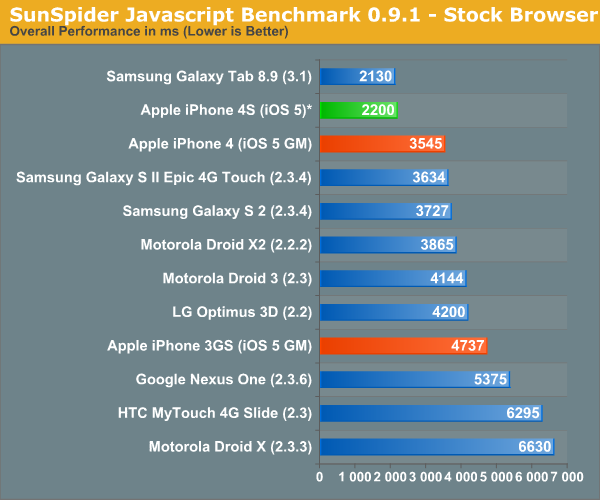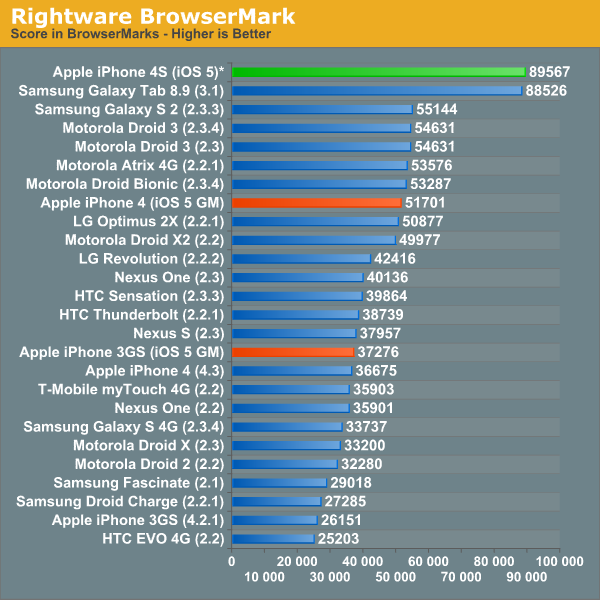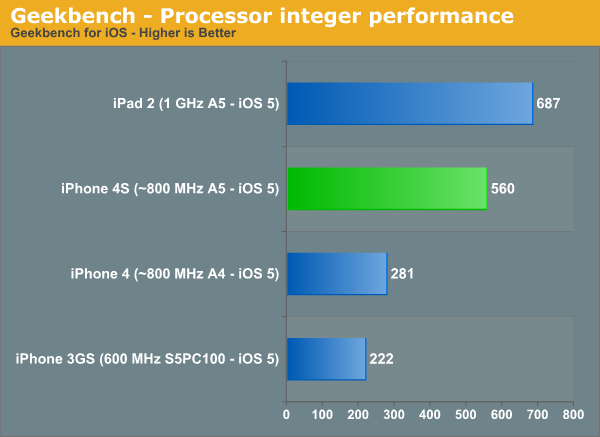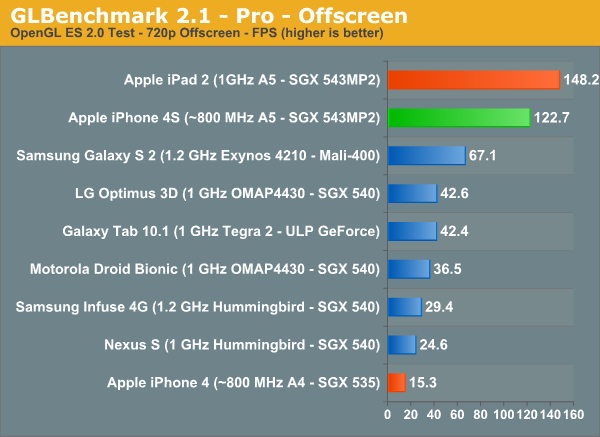iPhone 4S Preliminary Benchmarks: ~800MHz A5, Slightly Slower GPU than iPad 2, Still Very Fast
by Anand Lal Shimpi & Brian Klug on October 11, 2011 3:22 AM EST- Posted in
- Smartphones
- Apple
- Mobile
- iPhone 4S
- SoCs
Apple's ability to control the entire information chain, down to the point of limiting leaks, appears to be gradually slipping as it grows as a company. Case in point are the numerous hardware and performance leaks surrounding the newly launched iPhone 4S. Little did we know that several weeks ago we were staring at photos of the 4S' PCB, and more recently we've seen the first performance results from Apple's first A5 based smartphone thanks to a few eager users around the web. We've compiled these results here from various sources (all linked below) and compared them to our existing database of tests.
The results are pretty much as expected. Javascript performance finally catches up to Tegra 2 based Honeycomb devices, while general CPU performance is significantly higher than the iPhone 4. I suspect Ice Cream Sandwich will bridge the Android smartphone gap (the Honeycomb equipped Gtab 8.9 is here to give you an idea of where a more modern Android browser ends up).
Keep in mind that all of these tests measure performance of the software stack in addition to the hardware. In particular the web browser tests depend largely on browser optimizations, which is why we see differences between similar hardware running different browser versions. Also note that all results were run at stock, with the stock browser. Finally, although these browser tests were captured on video we'll still be running our official tests once our 4Ses arrive and will update accordingly.


Using some of the integer and fp tests of published Geekbench scores we can already conclude that Apple is shipping a lower clocked A5 in the iPhone 4S than it does in the iPad 2. This naturally makes sense as the iPhone 4S has a much smaller 5.25 Whr battery. Based on the Geekbench results it looks like the iPad 2 is clocked around 25% higher than the iPhone 4S, pegging the latter's clock speed at 800MHz.


A lower clock not only means higher yields from the factory, but likely a lower operating voltage as well. Dropping a CPU's core voltage, yields a greater-than-linear decrease in power consumption, making the marginal loss in clock speed a good choice. At a lower operating frequency than its Android competitors, Apple does have to exploit its strengths in software to avoid any tangible performance penalties. Apple has traditionally done this very well in the past, so I don't expect the loss of frequency to be a huge deal to the few who do cross-shop iOS and Android.
Unsurprisingly, memory bandwidth doesn't appear to have gone up either compared to the iPad 2's A5 (taking into account scaling due to CPU clock increases). The Samsung part number on the iPad 2's A5 indicates two LPDDR2-800 die on package, it's safe to assume that whatever Apple clocked the memory interface at in the iPad 2 remains unchanged in the iPhone 4S.
The GPU results tell a similar story courtesy of some early GLBenchmark 2.1 results. The 960 x 640 results are useless as they are bound by vsync at ~60 fps. Luckly GLBenchmark 2.1 added an off-screen render mode at 1280 x 720 where we can really see the differences between the iPad 2 and iPhone 4S A5 implementations:


Here the iPad 2 holds a ~21% performance advantage, which once again I assume to be all related to clock speed. Also note the huge advantage over the existing iPhone 4. The GPU power in the 4S should be more than enough to run any well written, current generation title at well north of 30 fps on its display.
We'll be reviewing the iPhone 4S in the coming weeks, stay tuned!
Source: GLBenchmark Database, Geekbench Database, Macrumors










216 Comments
View All Comments
doobydoo - Sunday, October 16, 2011 - link
Did you run the OpenGL test too? And find out that your phone is less than half as fast as the iPhone 4S?xdoylex26 - Tuesday, October 11, 2011 - link
my previous comment got deleted for an unknown reason.anyways, check out a firefox beta sunspider score on your GS2. It will be about 1400ms . I know this because I just did it. Nothing to see here folks.
awokado - Tuesday, October 11, 2011 - link
I just run SunSpider JavaScript Benchmark on mytouch 4g with cm7.1, score is 3147mytouch 4g is 1 GHz Qualcomm Snapdragon S2 MSM8255 processor with Adreno 205 GPU
ab303 - Wednesday, October 12, 2011 - link
ipad-2/iphone4s results are inflated for glbenchmark.i suspect a bug in ios port of glbenchmark.
in an intermediate version of glb2.1 with vsync on, Egypt was ~ 38FPS for 720p offscreen with vsync on, on the IPAD-2. The new version of glbenchmark removes the vsync, and the result now shoots up to 85.7! this is too good to be true.
kishonti needs to double check the sanity of the new version of glbenchmark, before people get misleaded thinking the IPAD-2 GPU is much superior compared to mali400/adreno220.
JaM1977 - Wednesday, October 12, 2011 - link
Why only 2 of 8 GLbenchmark 2.1 tests are posted, especially those least accurate (offscreen rendering)? in other tests it wasnt so dominant, especially against SGS2Mali-400 is more powerfull graphic chip than SGX543MP2
iphone4s/SGX543MP2 7760kVertex/s 14773kShader/s
sgs2/Mali-400 7880kVertex/s 23090kShader/s
doobydoo - Sunday, October 16, 2011 - link
The SGX543MP2 has more than DOUBLE the performance of the Mali-400, which now looks very slow and dated in comparison.The benchmarks included were the only OpenGL benchmarks which weren't limited by VSYNC - in other words the best representation of reality.
Sorry but the Mali-400 just doesn't cut it.
valnar - Wednesday, October 12, 2011 - link
Android is slow. I used to have an Android phone and the equivalent iPhone has always been snappier, even with a slower processor. All the Android phones that have fast processors *need* them to compensate for the crappy written OS. I'm not an Apple fanboi, and I don't own any other Apple products, but I love my iPhone 4. It's fast and does everything I want. (Still hate iTunes though).AnandReader1999 - Wednesday, October 12, 2011 - link
@ValnarYou mistake a closed environment that is 5 years old as being superior.
You correct that Android has been slow in the past, but that has been inefficient hardware, manufacturer bloat and an immature Android OS that is only 2 years old.
Reality is that Apple is in danger of being crushed by an OS in its infancy because it has several manufacturer's pumping out state of the art products at a rate Apple can't hope to compete with. The only downside....the infancy of the OS and it is growing in leaps and bounds.
As for new phones...you need to use a Galaxy SG2 stock. Its lightning fast, $25 bucks (or less) when its on sale. You can stream youtube videos to it (21mps vs 14.4 on 4S) and watch flash inside web browers.....you can even tell the Dolphin HD (downloadable browser) browser to display sites as a full desktop computer...again, complete with flash. My phone has become a laptop. Something the iPhone can never be at this point, since it only supports 'some' web standards, as seen fit by Apple.
doobydoo - Sunday, October 16, 2011 - link
'Lightning fast' - if lightning means travelling half as fast.It's cheaper because it's worse, not to mention the freezing issues and battery life issues.
Apple supports all web standards apart from Flash, a decision which has any many benefits as drawbacks. Flash can be used with an app if necessary.
All iPhones can zoom websites out to full screen too.. jeez.
Paulman - Tuesday, October 18, 2011 - link
AnandReader1999 meant that you can view the full desktop version of the websites (instead of the mobile versions) automatically with that browser. I think you can do that by setting the UAstring in your Android phone settings, too.But his bottom line with that point is that you don't have to trade anything off vs. a laptop when you're browsing on your Galaxy S II because Flash works. That's something the iPhone can't give you.
Now, I wonder if the "Call phone" feature will work on the Galaxy S II's "desktop version" of the Gmail website... (I was Googling that a few days ago. Managed to find one mention of it working on a Xoom tablet...)